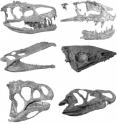Dinosaurs' 'superiority' challenged by their crocodile cousins
In a paper published today in Science, Steve Brusatte and Professor Mike Benton challenge the general consensus among scientists that there must have been something special about dinosaurs that helped them rise to prominence. Dinosaurs epitomize both success and failure. Failure because they went extinct suddenly 65 million years ago; success because they dominated terrestrial ecosystems for well over 100 million years evolving into a wide array of species that reached tremendous sizes.
But why were the dinosaurs able to become so successful, so diverse, so large? Many scientists argue that they must have had some feature or characteristic that helped them out-compete other vertebrate groups, including crocodiles and close crocodile cousins.
Mr Brusatte and Professor Benton are the first to look at the overall picture of the evolution of dinosaurs and their closest competitors during the Triassic period (251 to 199 million years ago). First, they identified the most likely 'competitors' to early dinosaurs: the crurotarsan archosaurs, a large group of animals that are closely related to crocodiles, which form one half of the group Archosauria, the other half being dinosaurs (and their descendants, the birds).
Unlike today's crocodiles, Triassic crurotarsans were amazingly diverse. There were enormous quadrupedal predators, slender bipedal predators, swift bipedal omnivores, fish-eaters, root-grubbers, and low-to-mid-browsing herbivores. Many of these crurotarsans look nothing like crocodiles, but instead are eerily similar to dinosaurs and, in fact, have been mistaken for dinosaur ancestors, or even true dinosaurs, in the past.
Crurotarsans and dinosaurs clearly shared many niches in the Late Triassic, looked very similar, and were thus very likely to be competing for similar resources.
The researchers examined the evolutionary pattern of dinosaurs and crurotarsans in the Late Triassic. Using a very large dataset of anatomical characters – nearly 500 features of the skeleton – and a new family tree of the entire archosaur group, they measured evolutionary rates and morphological disparity (a measurement of the range of different body plans and lifestyles that a group has).
They found no difference in the rates at which dinosaurs and crurotarsans were evolving. This was surprising as, if dinosaurs were truly 'superior' or 'out-competing' crurotarsans in the Triassic, they should be expected to evolve faster. Instead, crurotarsans were keeping pace.
The results for the second measure, morphological disparity, were even more remarkable. Crurotarsans had a much higher disparity than dinosaurs in the Triassic. In other words, crurotarsans were exploring a larger range of body types, diets, and lifestyles. This greatly contrasts with the classic image of dinosaur superiority since their greatest competitors, the crurotarsans, were doing so much more.
To these surprising results can be added two other, previously known, findings: crurotarsans were more abundant (more individuals, more fossils, more species) than dinosaurs in many Triassic ecosystems, and crurotarsans were in some cases more diverse (greater number of species). Putting all this together, it is very difficult to argue that dinosaurs were 'superior' to crurotarsans, or that they were out-competing crurotarsans.
Steve Brusatte, who conducted the research while an MSc student in Bristol University's Department of Earth Sciences, said: "If we were standing in the Late Triassic, 210 million years ago or so, and had to bet on which group would eventually dominate ecosystems, all reasonable gamblers would go with the crurotarsans. There was no sign that dinosaurs were eventually going to succeed so why did they? The answer is two mass extinction events: the dinosaurs not only got lucky, but they got lucky twice.
"They first weathered the storm during the Carnian-Norian event 228 million years ago, but so did the crurotarsans. In contrast, many other potential competitor groups went extinct. Then dinosaurs weathered a second, much bigger, storm 200 million years ago. This was the end Triassic extinction event, which was a sudden and catastrophic extinction caused by rapid climate change, possibly facilitated by an asteroid impact. Strangely, and suddenly, all crurotarsans except for a few lineages of crocodiles went extinct. On the other hand, the dinosaurs did not. They survived and then radiated in the Early Jurassic, and very quickly established themselves as the dominant vertebrate group on land across the world.
"Why did crurotarsans go extinct and not dinosaurs? We don't know the answer to that, but we suspect that it was nothing more than luck, plain and simple."
Source: University of Bristol
Articles on the same topic
- Luck gave dinosaurs their edgeThu, 11 Sep 2008, 18:22:49 UTC
Other sources
- Dinosaurs' 'superiority' challenged by their crocodile cousinsfrom Biology News NetFri, 12 Sep 2008, 3:42:24 UTC
- Good Luck, Not Superiority, Gave Dinosaurs Their Edge, Study Of Crocodile Cousins Revealsfrom Science DailyFri, 12 Sep 2008, 1:28:12 UTC
- Dinosaurs' Rise Due to "Blind Luck," Study Saysfrom National GeographicThu, 11 Sep 2008, 20:14:15 UTC
- Lucky break allowed dinosaurs to rule Earth: studyfrom Reuters:ScienceThu, 11 Sep 2008, 19:56:06 UTC
- Why dinosaurs ruled: Just plain luckfrom MSNBC: ScienceThu, 11 Sep 2008, 19:42:14 UTC
- Was the Dinosaurs' Long Reign on Earth a Fluke?from Scientific AmericanThu, 11 Sep 2008, 19:42:12 UTC
- Dinosaurs lucked into dominance, researchers suggestfrom CBC: Technology & ScienceThu, 11 Sep 2008, 19:21:17 UTC
- Luck gave dinosaurs their edgefrom PhysorgThu, 11 Sep 2008, 18:35:41 UTC
- Why Dinosaurs Ruled: Just Plain Luckfrom Live ScienceThu, 11 Sep 2008, 18:14:22 UTC
